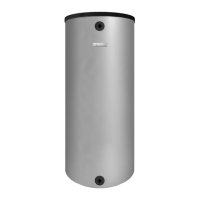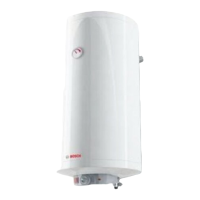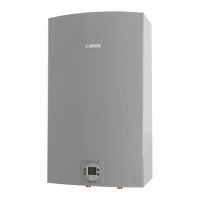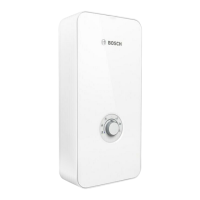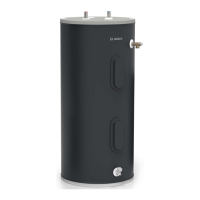6 720 644 942
6
Installation instructions
3 Installation instructions
3.1 Introduction
Please follow these instructions. Failure to follow
instructions may result in:
B Damage or injury.
B Improper operation.
B Loss of warranty.
If you are unable to perform the tasks required to install
this heater properly, please contact a locally licensed
plumber or gas technician.
Please contact Bosch Water Heating with any
questions.
3.2 Proper location for installing your
heater
Carefully select the location of the water heater. For
your safety and for proper heater operation, you must
provide combustion air to the heater and a proper
exhaust vent system.
Follow the guidelines below:
B 1. Common installation practice is to determine the
venting system layout and penetration first, then work
back to the heater.
B 2. Locate the heater where venting, gas and plumb-
ing connections are feasible and convenient.
B 3. The hot water lines should be kept short to save
energy. Centrally locating the water heater is best. It
is always best to have hot water lines insulated.
3.3 Venting
B Minimum vent pipe diameter: 5 inches
B Minimum vertical vent height: 6 feet, with no elbows
B Establish 12 inch rise before any elbow
The heater must be vented to the outside following all
local ordinances and specifications for installing a gas
appliance vent or chimney. The heater must be located
as close as practicable to a vertically rising chimney or
vent that has a listed vent cap at its termination point.
The venting system must be designed and constructed
so as to develop a positive flow adequate to remove flue
gasses to the outdoors. Consult the National Fuel Gas
Code if the vent will have elbows or share venting with
another natural draft appliance.
3.3.1 Horizontal venting
An AQ4 powervent, with a proof-of-draft safety interlock
device, is required and is available for sidewall venting.
Contact your dealer. In the Commonwealth of
Massachusetts power vented applications must utilize
proof-of-draft safety interlock device and comply with
regulations established for all side wall horizontally
vented gas fueled equipment.
3.3.2 Vertical venting
B A 5 inch diameter gas vent constructed of double
wall Type B gas vent is recommended. A 6 inch vent
is required in elevations greater than 2000 feet, see
Fig. 10. Under no circumstances must the vent pipe
be reduced in size.
Warning: The water in this water
heater is cold and always remains cold
except for the times that hot water is
being used. DO NOT INSTALL IN AN
AREA WHERE IT COULD FREEZE.
Drain the heater entirely if freezing
temperatures are anticipated in area
where heater is installed. See chapter
4.6 for draining instructions.
To prevent any freeze damage,
introduce short bursts of compressed
air (20-40psi) through these
connections to remove the residual
water in the horizontal pipes and water
valve.
Warning: Flammable materials,
gasoline, pressurized containers, or any
other items or articles that are potential
fire hazards must NOT be placed on or
adjacent to the heater. The appliance
area must be kept free of all
combustible materials, gasoline and
other flammable vapors and liquids.
Warning: Place the heater in a location
where water leaks will do NO DAMAGE
to adjacent areas.
Danger: Do not reduce the vent pipe
size. Do not put an elbow directly on top
of heater. Failure to follow venting
requirements may result in dangerous
exhaust gases entering living space.
Warning: Do not combination vent with
a power vented appliance.
Warning: Horizontally venting to a
vertically constructed vent stack along
an outside wall of a building is not
permissible.
Warning: Horizontally venting to a
sidewall vent terminator (without
powervent) is not permissible.
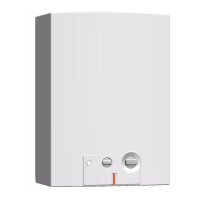
